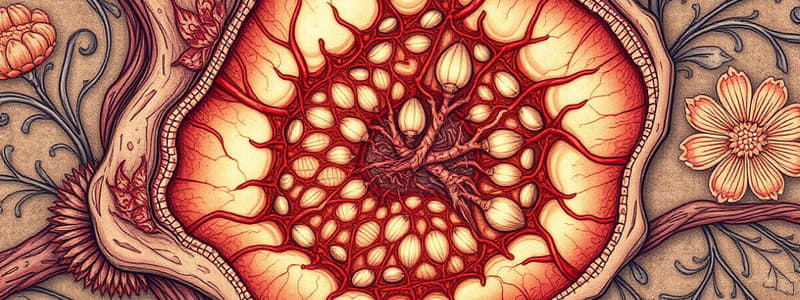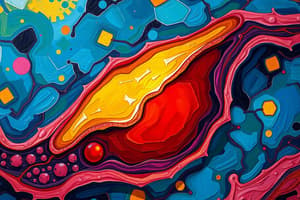Podcast
Questions and Answers
What is the primary mechanism for repair when an injury involves only the epithelial layer?
What is the primary mechanism for repair when an injury involves only the epithelial layer?
- Fibrous tissue formation
- Epithelial regeneration (correct)
- Skeletal muscle regeneration
- Scar tissue formation
What role do neutrophils play during the first 24 hours after a surgical incision?
What role do neutrophils play during the first 24 hours after a surgical incision?
- They replace macrophages in the wound.
- They initiate collagen fiber formation.
- They promote vascularity in the area.
- They arrive at the incision margin to mediate inflammation. (correct)
What significant change occurs by day 3 of healing following an incision?
What significant change occurs by day 3 of healing following an incision?
- Full restoration of dermal appendages
- Complete epithelial regeneration
- Replacement of neutrophils with macrophages (correct)
- Maximum scar formation
What indicates the peak of neovascularization during the healing process?
What indicates the peak of neovascularization during the healing process?
What change occurs during the second week of healing?
What change occurs during the second week of healing?
What is the condition of the epidermis by 4 weeks after the incision?
What is the condition of the epidermis by 4 weeks after the incision?
Which process occurs as dehydration occurs after an incision?
Which process occurs as dehydration occurs after an incision?
Flashcards are hidden until you start studying
Study Notes
Epithelial Layer Injury and Repair
- Injury involving only the epithelial layer is primarily repaired through epithelial regeneration.
- Surgical incisions trigger a cascade of events for healing.
Coagulation and Initial Response
- Coagulation pathways are activated upon injury; a clot forms to halt bleeding and serves as a scaffold for cell migration.
- Dehydration leads to scab formation.
Early Cell Activity
- Within 24 hours, neutrophils are present at the incision margin.
- Between 24 to 48 hours, epithelial cells migrate from both edges and proliferate along the dermis, laying down basement membrane components.
Transition of Immune Cells
- By day 3, neutrophils are largely replaced by macrophages, indicating a shift in the immune response.
- Granulation tissue begins to invade the incision space with visible collagen fibers at the margins.
Vascular Changes
- By day 5, neovascularization reaches its peak, enhancing blood supply to the area.
- The epidermis begins to restore its normal thickness as surface cells mature and undergo keratinization.
Continued Healing and Scar Formation
- During the second week, collagen accumulation and fibroblast proliferation continue, with reduced leukocyte presence, edema, and vascularity.
- By 4 weeks, a mature scar is formed, displaying minimal inflammatory cells.
- Although the epidermis returns to normal, any dermal appendages destroyed in the incision area are permanently lost.
Studying That Suits You
Use AI to generate personalized quizzes and flashcards to suit your learning preferences.




